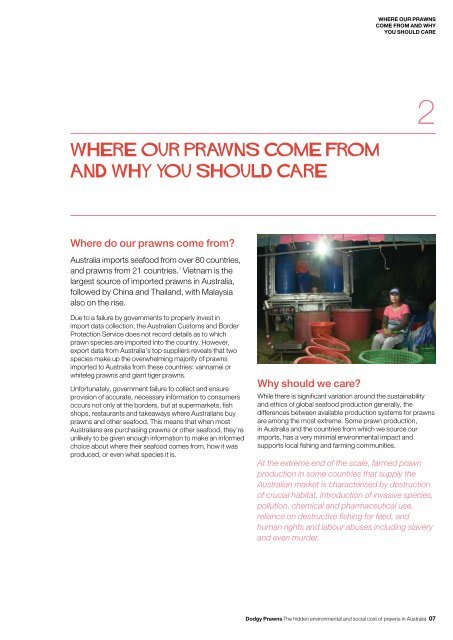Prawns
UREzh60p
UREzh60p
Create successful ePaper yourself
Turn your PDF publications into a flip-book with our unique Google optimized e-Paper software.
WHERE OUR PRAWNS<br />
COME FROM AND WHY<br />
YOU SHOULD CARE<br />
Where our prawns come from<br />
and why you should care<br />
2<br />
Where do our prawns come from?<br />
Australia imports seafood from over 80 countries,<br />
and prawns from 21 countries. 7 Vietnam is the<br />
largest source of imported prawns in Australia,<br />
followed by China and Thailand, with Malaysia<br />
also on the rise.<br />
Due to a failure by governments to properly invest in<br />
import data collection, the Australian Customs and Border<br />
Protection Service does not record details as to which<br />
prawn species are imported into the country. However,<br />
export data from Australia’s top suppliers reveals that two<br />
species make up the overwhelming majority of prawns<br />
imported to Australia from these countries: vannamei or<br />
whiteleg prawns and giant tiger prawns.<br />
Unfortunately, government failure to collect and ensure<br />
provision of accurate, necessary information to consumers<br />
occurs not only at the borders, but at supermarkets, fish<br />
shops, restaurants and takeaways where Australians buy<br />
prawns and other seafood. This means that when most<br />
Australians are purchasing prawns or other seafood, they’re<br />
unlikely to be given enough information to make an informed<br />
choice about where their seafood comes from, how it was<br />
produced, or even what species it is.<br />
Why should we care?<br />
While there is significant variation around the sustainability<br />
and ethics of global seafood production generally, the<br />
differences between available production systems for prawns<br />
are among the most extreme. Some prawn production,<br />
in Australia and the countries from which we source our<br />
imports, has a very minimal environmental impact and<br />
supports local fishing and farming communities.<br />
At the extreme end of the scale, farmed prawn<br />
production in some countries that supply the<br />
Australian market is characterised by destruction<br />
of crucial habitat, introduction of invasive species,<br />
pollution, chemical and pharmaceutical use,<br />
reliance on destructive fishing for feed, and<br />
human rights and labour abuses including slavery<br />
and even murder.<br />
Dodgy <strong>Prawns</strong> The hidden environmental and social cost of prawns in Australia 07


